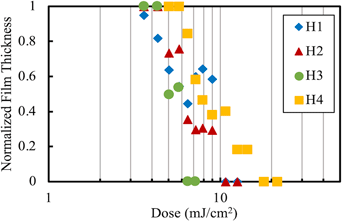Crossref Citations
This article has been cited by the following publications. This list is generated based on data provided by
Crossref.
Deng, Jingyuan
Bailey, Sean
Jiang, Shaoyi
and
Ober, Christopher K.
2022.
Modular Synthesis of Phthalaldehyde Derivatives Enabling Access to Photoacid Generator-Bound Self-Immolative Polymer Resists with Next-Generation Photolithographic Properties.
Journal of the American Chemical Society,
Vol. 144,
Issue. 42,
p.
19508.
Deng, Jingyuan
Bailey, Sean
Jiang, Shaoyi
and
Ober, Christopher K.
2022.
High-Performance Chain Scissionable Resists for Extreme Ultraviolet Lithography: Discovery of the Photoacid Generator Structure and Mechanism.
Chemistry of Materials,
Vol. 34,
Issue. 13,
p.
6170.
Liu, Lifei
Li, Jintong
Song, Ting
Wu, Rong
Zhao, Weizhen
and
Huo, Feng
2023.
Synthesis of Acrylate Dual-Tone Resists and the Effect of Their Molecular Weight on Lithography Performance and Mechanism: An Investigation.
Materials,
Vol. 16,
Issue. 6,
p.
2331.
Shin, Youngsu
Schwartz, Jared M.
Engler, Anthony C.
Jones, Brad
Davydovich, Oleg
and
Kohl, Paul A.
2024.
Photoactivated Cyclic Polyphthalaldehyde Microcapsules for Payload Delivery.
ACS Applied Materials & Interfaces,
Vol. 16,
Issue. 33,
p.
43951.
Cen, Jie
Deng, Zhengyu
and
Liu, Shiyong
2024.
Emerging trends in the chemistry of polymeric resists for extreme ultraviolet lithography.
Polymer Chemistry,
Vol. 15,
Issue. 45,
p.
4599.
Lu, Xin‐Yu
Zhang, Rui‐Sheng
Yang, Guan‐Wen
Li, Qiang
Li, Bo
and
Wu, Guang‐Peng
2024.
Aqueous Developable and CO2‐Sourced Chemical Amplification Photoresist with High Performance.
Angewandte Chemie International Edition,
Vol. 63,
Issue. 32,
Lu, Xin‐Yu
Zhang, Rui‐Sheng
Yang, Guan‐Wen
Li, Qiang
Li, Bo
and
Wu, Guang‐Peng
2024.
Aqueous Developable and CO2‐Sourced Chemical Amplification Photoresist with High Performance.
Angewandte Chemie,
Vol. 136,
Issue. 32,
Schwartz, Jared M.
Kohl, Paul A.
and
Engler, Anthony
2024.
Scaling the polymerization of polyaldehydes through continuous flow synthesis.
MRS Communications,
Vol. 14,
Issue. 5,
p.
970.
Lopez Ninantay, Jose
Engler, Anthony
Schwartz, Jared
Kohl, Paul
Guerrero, Douglas
and
Amblard, Gilles R.
2024.
Positive-tone, dry-develop poly(aldehyde) photoresist.
p.
15.
Lopez Ninantay, Jose
Engler, Anthony
Schwartz, Jared
and
Kohl, Paul A.
2024.
Chemically Amplified, Dry-Develop Poly(aldehyde) Photoresist.
ECS Journal of Solid State Science and Technology,
Vol. 13,
Issue. 5,
p.
054004.
Naqvi, Bilal A.
Schwartz, Jared
Engler, Anthony
Kohl, Paul A.
De Gendt, Stefan
and
De Simone, Danilo
2025.
Analysis of EUV induced depolymerization and side reactions of polyphthalaldehydes for dry develop EUV resist applications.
Journal of Materials Chemistry C,
Vol. 13,
Issue. 17,
p.
8571.
Park, Soo Woong
Kim, Myung Jun
and
Kim, Jae Jeong
2025.
Pretreatments for photoresist-patterned wafer to improve Cu pillar electrodeposition.
Journal of Industrial and Engineering Chemistry,
Vol. 145,
Issue. ,
p.
403.
